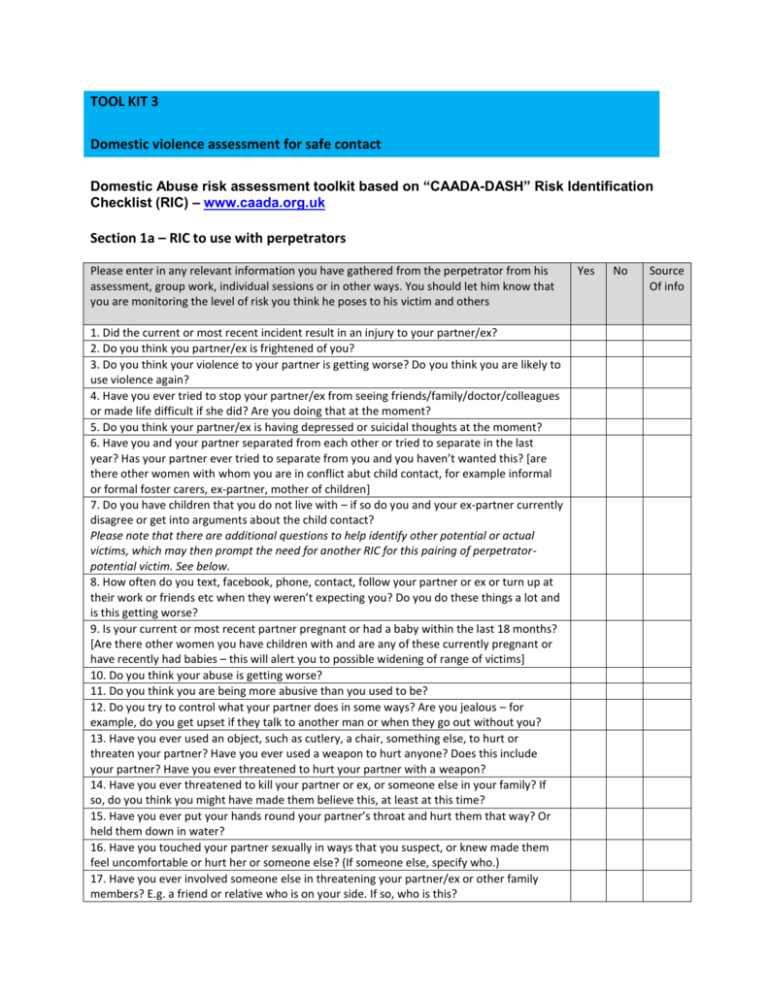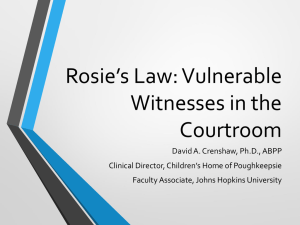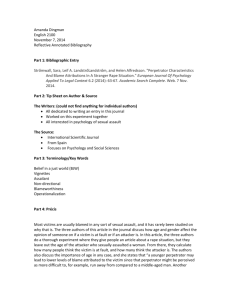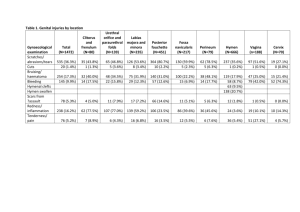Domestic Violence Risk Assessment Toolkit (CAADA-DASH)
advertisement

TOOL KIT 3 Domestic violence assessment for safe contact Domestic Abuse risk assessment toolkit based on “CAADA-DASH” Risk Identification Checklist (RIC) – www.caada.org.uk Section 1a – RIC to use with perpetrators Please enter in any relevant information you have gathered from the perpetrator from his assessment, group work, individual sessions or in other ways. You should let him know that you are monitoring the level of risk you think he poses to his victim and others 1. Did the current or most recent incident result in an injury to your partner/ex? 2. Do you think you partner/ex is frightened of you? 3. Do you think your violence to your partner is getting worse? Do you think you are likely to use violence again? 4. Have you ever tried to stop your partner/ex from seeing friends/family/doctor/colleagues or made life difficult if she did? Are you doing that at the moment? 5. Do you think your partner/ex is having depressed or suicidal thoughts at the moment? 6. Have you and your partner separated from each other or tried to separate in the last year? Has your partner ever tried to separate from you and you haven’t wanted this? [are there other women with whom you are in conflict abut child contact, for example informal or formal foster carers, ex-partner, mother of children] 7. Do you have children that you do not live with – if so do you and your ex-partner currently disagree or get into arguments about the child contact? Please note that there are additional questions to help identify other potential or actual victims, which may then prompt the need for another RIC for this pairing of perpetratorpotential victim. See below. 8. How often do you text, facebook, phone, contact, follow your partner or ex or turn up at their work or friends etc when they weren’t expecting you? Do you do these things a lot and is this getting worse? 9. Is your current or most recent partner pregnant or had a baby within the last 18 months? [Are there other women you have children with and are any of these currently pregnant or have recently had babies – this will alert you to possible widening of range of victims] 10. Do you think your abuse is getting worse? 11. Do you think you are being more abusive than you used to be? 12. Do you try to control what your partner does in some ways? Are you jealous – for example, do you get upset if they talk to another man or when they go out without you? 13. Have you ever used an object, such as cutlery, a chair, something else, to hurt or threaten your partner? Have you ever used a weapon to hurt anyone? Does this include your partner? Have you ever threatened to hurt your partner with a weapon? 14. Have you ever threatened to kill your partner or ex, or someone else in your family? If so, do you think you might have made them believe this, at least at this time? 15. Have you ever put your hands round your partner’s throat and hurt them that way? Or held them down in water? 16. Have you touched your partner sexually in ways that you suspect, or knew made them feel uncomfortable or hurt her or someone else? (If someone else, specify who.) 17. Have you ever involved someone else in threatening your partner/ex or other family members? E.g. a friend or relative who is on your side. If so, who is this? Yes No Source Of info 18. Have you ever hurt anyone beside your partner/ex? Someone like an ex-partner, but also any other family member, friend, colleague, someone you know casually. Someone you don’t know well, a stranger, children, another family member, someone from previous family relationship, ex-partner’s new partner, acquaintance. If so, please say who (make a list if necessary) 19. Have you ever mistreated the family pet or other animal, such as neighbour’s dog or something like that? 20. Do you currently have money worries or have you recently lost your job or worry about losing it? Do you feel under financial pressure? Are you currently in disagreement with your partner/ex over money problems and do these sometimes cause big arguments? [tick yes if he answers yes to any of these- they are all just different ways of asking about risks arising from finance] 21. Are you using any drugs or have you in the last few years used drugs or alcohol to the point where people tell you it is a problem or you start to worry it is a problem or start spending money you can’t afford on drugs or alcohol or pass out from drug or alcohol use? Are you currently depressed or have any other problems with your mental health? Are you taking any medication for depression or other mental illness? 22. Have you ever thought about or threatened suicide or tried to kill yourself? 23. Have you ever had a bail order or injunction/order telling you not to contact or hurt your partner/ ex or the children? If so, have you ever ignored that order and done something it said you shouldn’t do, like calling on them to give the kids presents or something else like that? 24. Have you ever been in any trouble with the police? Do you have any criminal convictions? [you can emphasise that you can ask the police to check their records but would prefer it if they were honest with you in the first place.] If so what type of criminal activity Section 1b - Additional specific questions for perpetrators Please enter in any relevant information you have gathered from the perpetrator from his assessment, group work, individual sessions etc. 1. Are you/is he in a new relationship since ending the one with the primary victim? If you have answered yes to the above please complete a new RIC specifically for this relationship, ensure that relevant information is collected about additional children where they exist. 2. Is your/ is his ex-partner is a new relationship and are upset or angry about this? 3. Have you/ has he threatened your ex-partner’s new partner? 4. Are there other women in your/ his life who have felt threatened by your/his behaviour? 5. If you have answered yes to the above please assess the risk to this person and their needs for safety, if necessary complete a separate RIC. 6. Has your/ his partner ever used any force against you/him? If you answered yes to the above please note that if the victim is using violence to protect themselves this can heighten the risk of serious violence as the abuser will usually increase levels of violence in return. This should be considered when thinking about the overall level of risk. Yes No Source 7. Do you keep a knife or gun at home or some sort of weapon, even if it is just for show? Do you have any hobbies which allow you contact with weapons? Does your job put you in contact with weapons? Have you ever been trained in combat techniques, such as in TA, martial arts etc? If you answered yes to the above On its own, having a hobby like these would not necessarily mean a risk of violence; however, coupled with a history of violence and other indicators of future risk it increases the likelihood that any future violence will be dangerous Need for a new RIC If any of these questions reveal the existence of other people the perpetrator may be a risk to, such as carer of his child (foster parent, family member) an ex-partner, particularly if they are the mother of a child of his, a new partner, his ex-partner’s new partner, this should prompt you to collect evidence you have about this pairing of perpetrator and potential victim, on a separate RIC. You will usually make proactive contact with any potential or likely victim, as part of the work of the Integrated Support Service for victims/partners/ex-partners. This will provide you with information you can combine with the information from the perpetrator. Section 2 - Third person version to combine information from all sources Please enter any relevant information you have gathered from the victim, perpetrator, referring agency, any other relevant agency, police records etc 1. Did the current or most recent incident result in an injury to victim? (is perpetrator denying this?) 2. Is victim frightened of perpetrator? 3. Is violence getting worse or more frequent? 4. Is victim being kept from seeing friends/family/doctor etc? 5. Is victim suicidal or depressed? 6. Is separation imminent? Has victim tried to separate before? 7. Is there disagreement about child contact? 8. Is perpetrator constantly checking up on victim (stalking)? 9. Has victim recently had baby or is she pregnant? 10. Is abuse getting worse or more controlling in effect? 11. Is abuse more frequent than it used to be? 12. Is perpetrator very jealous and controlling about victim’s contact with men? 13. Has perpetrator ever used a weapon against the victim or a previous one? 14. Has perpetrator ever threatened to kill victim or previous partner or someone else in family in ways which made them believe it? 15. Has perpetrator ever attempted to choke, strange, suffocate or drown victim or someone else? 16. Does the perpetrator denigrate their partner (ex-partner) sexually or physically abuse them (or others) sexually or coerce them into sexual behaviour that they are not comfortable with? 17. Are other people involved in hurting or threatening or policing victim? 18. Has perpetrator hurt others? Has perpetrator abused past partners? 19. Has perpetrator ever abused an animal, particularly a family pet? 20. Is perpetrator in financial crisis or making victim defendant on him for money, or facing unemployment? 21. Is perpetrator using drugs or alcohol in problematic ways? Is perpetrator currently depressed or have any other problems with mental health Yes No Don’t Know Source or taking any medication for depression or other mental illness? 22. Has perpetrator ever thought about or threatened suicide or tried to kill themselves? 23. Has perpetrator ever broken bail order or injunction? Are they denying this? 24. Does perpetrator have a criminal record? Is any of this for domestic violence? Section 3 – RIC version to use directly with victim Please explain that the purpose of asking these questions is for the safety and protection of the individual concerned. Tick the box if the factor is present. Please use the comment box at the end of the form to expand on any answer. It is assumed that your main source of information is the victim. If this is not the case please indicate in the right hand column 1. Has the current incident resulted in injury? (please state what and whether this is the first injury) 2. Are you very frightened? Comment: 3. What are you afraid of? Is it further injury or violence? (please give an indication of what you think (name of abuser(s)………..) might do and to whom, including children.) Comment: 4. Do you feel isolated from family/friends i.e. does (name of abuser(s)………..) try to stop you from seeing friends/family/doctor or others? Comment: 5. Are you feeling depressed or having suicidal thoughts? 6. Have you separated or tried to separate from (name of abuser(s)………..) within the past year? 7. Is there conflict over child contact? 8. Does (……….) constantly text, call, contact, follow, stalk or harass you? (Please expand to identify what and whether you believe that this is done deliberately to intimidate you? Consider the context and behaviour of what is being done.) 9. Are you pregnant or have you recently had a baby ( within the last 8 months)? 10. Is the abuse happening more often? 11. Is the abuse getting worse? 12. Does (……….) try to control everything you do and/or are they excessively jealous? (In terms of relationship, who you see, being “policed at home”, telling you what to wear for example. Consider “honour”-based violence and specify behaviour.) 13. Has (……….) ever used weapons or objects to hurt you? 14. Has (……….) ever threatened to kill you someone else and you believed them? (If yes, tick who.) Yes No Don’t know State source of info if not the victim e.g. police officer □ □ □ You Children Other (please specify) 15. Has (……….) ever attempted to strangle/choke/suffocate/drown you? 16. Does (……….) do or say things of a sexual nature that make you feel bad or that physically hurt you or someone else? (If someone else, specify who.) 17. Is there any other person who has threatened you or who you are afraid of? (If yes, please specify whom and why. Consider extended family if HBV.) Yes Tick the box if the factor is present. Please use the comment box at the end of the form to expand on any answer. No Don’t know State source of info if not the victim 18. Do you know if (……….) has hurt anyone else? (Please specify whom including the children, siblings, elderly relatives or animals. Consider HBV.) Children □ Another family member □ □ □ Someone from a previous relationship Other (please specify) 19. Has (……….) ever mistreated an animal or the family pet? 20. Are there any financial issues? For example, are you dependant on (……….) for money/have they recently lost their job/other financial issues? 21. Has (……….) had problems in the past year with drugs (prescription or other), alcohol or mental health leading to problems in leading a normal life? (If yes please specify which and relevant details if known.) □ □ □ Drugs Alcohol Mental Health 22. Has (……….) ever threatened or attempted suicide? 23. Has (……….) ever broken bail/ an injunction and/or formal agreement for when they can see you and/ or the children? (You may wish to consider this in relation to an ex-partner of the perpetrator if relevant.) Bail Conditions □ Non-Molestation/Occupation Order Child Contact arrangements □ □ □ □ Forced Marriage Protection Order Other 24. Do you know if (……….) has ever been in trouble with the police or has a criminal history? (If yes, please specify.) DV □ Sexual violence □ Other □ Total “yes” responses For consideration by professional: Is there any other relevant information (from victim or professional) which may increase risk levels? Consider victim’s situation in relation to disability, substance misuse, mental health issues, cultural/language barriers, “honour”-based systems and minimisation. Are they willing to engage with your service? Describe: Consider abuser’s occupation/interests – could this give them unique access to weapons? Describe: What are the victim’s greatest priorities to address the safety? Section 4: The Child/ren and Their Family (Consider use of safety planning and FGC) • Name and age of the child the D/V Perpetrator intends to have / has contact with • Are they known to Children’s Services? • Details of who they live with and their wider family network • The D/V Perpetrator’s status / relationship to the child. • Any welfare or developmental issues in respect of the child vulnerability /capacity to protect themselves. • The level of involvement by the D/V Perpetrator with the child – past and current, frequency, if contact has occurred/is occurring where is it taking palace, who else is present, purpose of contact, etc. What level of care giving is undertaken by the D/V Perpetrator? • The wishes feelings of the child inObtained relation to contact with this person Section 5: Riskand Analysis of Information • Include a view about whether you think the child's views are freely given or whether they may be under pressure, e g. from parent wanting a relationship with the D/V Perpetrator. Assess potentiating Factors inclusive of indicative behaviours, attitudes of D/V Perpetrator / Victim, Child and main carer Information about the main carer of the child: Vulnerability/Resilience factors of D/V Perpetrator / Victim, Child and main carer • Name, date of birth. • Are knownprotective to GYPS? factors If so, why? they Proactive/ • What is your assessment of their parenting capacity to protect from harm? (Please refer to thetodimensions of theMulti Core Assessment framework) Refer “Barnardos Agency Domestic Violence Risk Identification Threshold Scales - Maddie Bell, Barnardos, 2007 – see template within contact • Are there any factors which procedure guidance packimpact on the parents' / carers' capacity to protect from harm, e.g physical / mental illness, disability, poor experience of being parented , care history, childhood abuse, history of violence, alcohol, Substance misuse . (Please refer to the dimensions of the Core Assessment Framework) Section 6: Support and monitoring systems Describe the proposed supervision and monitoring arrangements if contact is assessed to be in the child’s best interests Section 7: Declaration and Signatures Name of Social worker completing assessment Signed and dated Team Manager comments and recommendations Signed and dated Section 8: Decision of Service Manager Decision Comments Any further information required Monitoring and Reviewing arrangements Safe Contact Indicator Derived from: CONTACT AND DOMESTIC VIOLENCE - THE EXPERTS' COURT REPORT DR CLAIRE STURGE in consultation with DR DANYA GLASER (2000) Indicator of safe contact + - Indicator of unsafe contact Child’s wishes & feelings Child freely wants contact Child freely does not want contact Child has positive memories Child has negative memories Pre-separation harm and its impact Child has not witnessed violence Child is not imitating violent behaviour Child is not afraid Child has witnessed violence Non abusing parent is not afraid Non abusing parent is afraid Prior harm to child is accepted Perpetrator accepts impact on victim Regret is expressed Prior harm to child is denied Perpetrator denies impact on victim No expression of regret Child is imitating violent behaviour Child is afraid Experiences during contact No abuse or neglect of child Contact not used to pursue conflict Non abusing parent is not undermined Contact is high-quality / reliable Abuse or neglect of child Safe arrangements are in place Arrangements are not safe Contact used to pursue conflict Non abusing parent is undermined Contact is low quality / unreliable Clear purpose of contact No realistic prospect of a beneficial relationship No realistic prospect of repairing a Will repair a ‘broken’ relationship ‘broken’ relationship No realistic prospect of Will contribute to child’s identity contributing to child’s identity Will maintain a beneficial relationship ** Add up the minus’s and plus’s as a rating ** Analysis of benefits and risks for this child, derived from the above:






